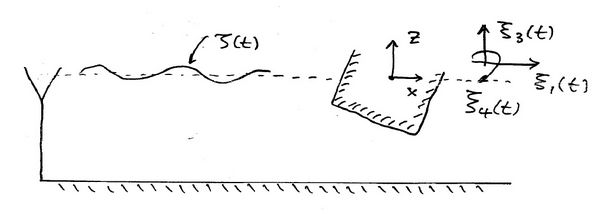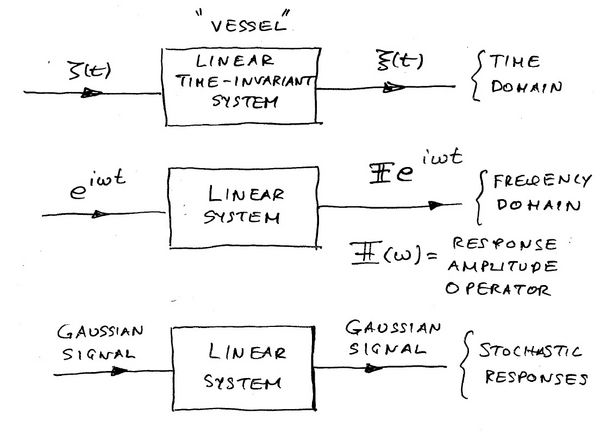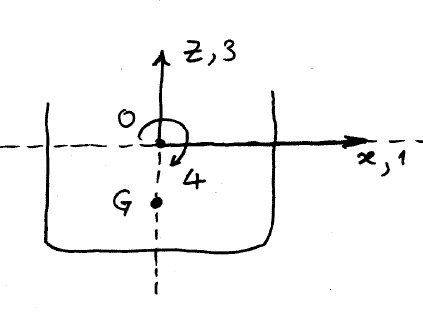Difference between revisions of "Linear Wave-Body Interaction"
| Line 37: | Line 37: | ||
<center> | <center> | ||
<math> | <math> | ||
| − | \phi = \phi^{\mathrm{I}} + \phi^{\mathrm{S} | + | \phi = \phi^{\mathrm{I}} + \phi^{\mathrm{S}} |
</math> | </math> | ||
</center> | </center> | ||
where <math>\phi^{\mathrm{I}}</math> is the incident potential and <math>\phi^{\mathrm{S}</math> | where <math>\phi^{\mathrm{I}}</math> is the incident potential and <math>\phi^{\mathrm{S}</math> | ||
is the scattered potential. The boundary condition for the scattered potential is | is the scattered potential. The boundary condition for the scattered potential is | ||
| + | |||
| + | <center><math> | ||
| + | \Delta\phi=0, \, -h<z<0,\,\,\,\mathbf{x} \in \Omega | ||
| + | </math></center> | ||
| + | <center><math> | ||
| + | \partial_n\phi = 0, \, z=-h, | ||
| + | </math></center> | ||
| + | <center><math> | ||
| + | \partial_n \phi =\mathrm{i} \omega \zeta\,z=0,\,\,\mathbf{x} \in F, | ||
| + | </math></center> | ||
| + | <center><math> | ||
| + | \mathrm{i} \omega \phi = -g\zeta,\,z=0,\,\,\mathbf{x} \in F, | ||
| + | </math></center> | ||
| + | (note that the latter two can be combined as | ||
| + | <center><math> | ||
| + | \partial_n \phi = \alpha \phi,\,z=0,\,\,\mathbf{x} \in F, | ||
| + | </math></center> | ||
| + | where <math>\alpha = \omega^2/g </math>) | ||
== Linear wave-body interactions == | == Linear wave-body interactions == | ||
Revision as of 23:49, 31 August 2009
| Wave and Wave Body Interactions | |
|---|---|
| Current Chapter | Linear Wave-Body Interaction |
| Next Chapter | Added-Mass, Damping Coefficients And Exciting Forces |
| Previous Chapter | Ship Kelvin Wake |
Introduction
We derive here the equations of motion for a body in Linear Plane Progressive Regular Waves in the frequency domain in two dimensions. We begin with the equations for a fixed body and then consider the equations for a rigid body.
Frequency Domain Equations
We assume small amplitude so that we can linearise all the equations (see Linear and Second-Order Wave Theory). We also assume that Frequency Domain Problem with frequency [math]\displaystyle{ \omega }[/math] and we assume that all variables are proportional to [math]\displaystyle{ \exp(-\mathrm{i}\omega t)\, }[/math] The water motion is represented by a velocity potential which is denoted by [math]\displaystyle{ \phi\, }[/math] so that
[math]\displaystyle{ \Phi(\mathbf{x},t) = \mathrm{Re} \left\{\phi(\mathbf{x},\omega)e^{-\mathrm{i} \omega t}\right\}. }[/math]
The coordinate system is the standard Cartesian coordinate system with the [math]\displaystyle{ z- }[/math]axis pointing vertically up. The water surface is at [math]\displaystyle{ z=0 }[/math] and the region of interest is [math]\displaystyle{ -h\lt z\lt 0 }[/math]. There is a body which occupies the region [math]\displaystyle{ \Omega }[/math] and we denote the wetted surface of the body by [math]\displaystyle{ \partial\Omega }[/math] We denote [math]\displaystyle{ \mathbf{r}=(x,y) }[/math] as the horizontal coordinate in two or three dimensions respectively and the Cartesian system we denote by [math]\displaystyle{ \mathbf{x} }[/math]. We assume that the bottom surface is of constant depth at [math]\displaystyle{ z=-h }[/math]. Variable Bottom Topography can also easily be included.
The equations are the following
(note that the last expression can be obtained from combining the expressions:
where [math]\displaystyle{ \alpha = \omega^2/g \, }[/math])
where [math]\displaystyle{ \mathcal{L} }[/math] is a linear operator which relates the normal and potential on the body surface through the physics of the body.
The simplest case is for a fixed body where the operator is [math]\displaystyle{ L=0 }[/math] and we will consider this boundary condition first before moving on to floating bodies.
The equation is subject to some radiation conditions at infinity. We assume the following. [math]\displaystyle{ \phi^{\mathrm{I}}\, }[/math] is a plane wave travelling in the [math]\displaystyle{ x }[/math] direction,
where [math]\displaystyle{ A }[/math] is the wave amplitude (in potential) [math]\displaystyle{ \mathrm{i} k }[/math] is the positive imaginary solution of the Dispersion Relation for a Free Surface (note we are assuming that the time dependence is of the form [math]\displaystyle{ \exp(-\mathrm{i}\omega t) }[/math]) and
In two-dimensions the Sommerfeld Radiation Condition is
where [math]\displaystyle{ \phi^{\mathrm{{I}}} }[/math] is the incident potential.
Equations for a Fixed Body in Frequency Domain
The equations for a fixed body are
(note that the last expression can be obtained from combining the expressions:
where [math]\displaystyle{ \alpha = \omega^2/g \, }[/math]) The body boundary condition for a rigid body is just
plus the radiation conditions.
We decompose the potential as
[math]\displaystyle{ \phi = \phi^{\mathrm{I}} + \phi^{\mathrm{S}} }[/math]
where [math]\displaystyle{ \phi^{\mathrm{I}} }[/math] is the incident potential and [math]\displaystyle{ \phi^{\mathrm{S} }[/math] is the scattered potential. The boundary condition for the scattered potential is
(note that the latter two can be combined as
where [math]\displaystyle{ \alpha = \omega^2/g }[/math])
Linear wave-body interactions
Consider a Linear Plane Progressive Regular Wave interacting with a floating body in two dimensions (the main concepts survive almost with no change in the more practical three-dimensional problem). We begin by defining the following,
where the surge, heave and roll are the three rigid body motions which are possible in two dimensions.
Linear theory
We assume that we can apply linear theory to the motions, which are an extension of the linear equations for a free-surface. We assume that
This is an assumption of small wave steepness which is a reasonable assumption for gravity waves in most cases, except when waves are near breaking conditions. Furthermore we assume
These assumptions are valid in most cases and most bodies of practical interest, unless the vessel response at resonance is highly tuned or lightly damped. This is often the case for roll when a small amplitude wave interacts with a vessel weakly damped in roll.
Linear systems theory
The vessel dynamic responses in waves may be modelled according to linear system theory. By virtue of linearity, a random seastate may be represented as the linear superposition of Linear Plane Progressive Regular Waves (see Waves and the Concept of a Wave Spectrum)
where in deep water: [math]\displaystyle{ K_j = \frac{\omega_j^2}{g} \, }[/math]. Note that the sum here can be replace by an integral in many formulations. According to the theory of St. Denis and Pierson, the phases [math]\displaystyle{ \epsilon\, }[/math], are random and uniformly distributed between [math]\displaystyle{ ( - \pi, \pi ] \, }[/math]. For now we assume them known constants:
At [math]\displaystyle{ X=0\, }[/math]:
The corresponding vessel responses follow from linearity in the form:
Where [math]\displaystyle{ \Pi_K (\omega) \, }[/math] is the complex RAO (Response Amplitude Operator) for mode [math]\displaystyle{ K\, }[/math]. It is the object of linear seakeeping theory to derive equations for [math]\displaystyle{ \Pi\omega)\, }[/math] the frequency domain. The treatment in the stochastic case is then a simple exercise in linear systems.
Calculation of the RAO
The equations of motion for [math]\displaystyle{ \xi_K(t)\, }[/math] follow from Newton's law applied to each mode in two dimensions. The same principles apply with very minor changes in three dimensions
We begin by considering the equation in surge.
where [math]\displaystyle{ \frac{\mathrm{d}\xi_1}{\mathrm{d}t} = \dot\xi_1 \, }[/math] and [math]\displaystyle{ F_{1\omega} \, }[/math] is the force on the body due to the fluid pressures, by virtue of linearity, [math]\displaystyle{ F_{1\omega} \, }[/math] will be assumed to be a linear functional of [math]\displaystyle{ \xi_1, \dot\xi_1, \ddot\xi_1 \, }[/math]. Memory effects exist when surface waves are generated on the free surface, so [math]\displaystyle{ F_{1\omega} \, }[/math] depends in principle on the entire history of the vessel displacement. We adopt here the frequency domain formulation where the vessel motion has been going on over an infinite time interval, [math]\displaystyle{ (-\infty, t)\, }[/math] with [math]\displaystyle{ e^{i\omega t}\, }[/math] dependence.
We will therefore set:
In this case we can linearize the water induced force on the body as follows:
The same expansion applies for other modes, namely Heave ([math]\displaystyle{ K = 3 \, }[/math]) and Roll ([math]\displaystyle{ K=4 \, }[/math]). In sum:
- The added-mass matrix [math]\displaystyle{ A_{Kj} \, }[/math] represents the added inertia due to the acceleration of the body in water with acceleration [math]\displaystyle{ \ddot\xi_j\, }[/math].
- The damping matrix [math]\displaystyle{ B_{Kj}\, }[/math] governs the energy dissipation into the fluid domain in the form of surface waves.
- The hydrostatic restoring matrix [math]\displaystyle{ C_{Kj} \, }[/math] represents the system stifness due to the hydrostatic restoring forces and moments.
For harmonic motions, the matrices [math]\displaystyle{ A_{Kj} \, }[/math] and [math]\displaystyle{ B_{Kj} \, }[/math] are functions of [math]\displaystyle{ \omega\, }[/math], so we write [math]\displaystyle{ A_{Kj} (\omega), \ B_{Kj} (\omega)\, }[/math]. This functional form will be discussed below. The hydrostatic matrix [math]\displaystyle{ C_{Kj} \, }[/math] is independent of [math]\displaystyle{ \omega\, }[/math] and many of its elements are identically equal to zero. Collecting terms in the left-hand side and denoting by [math]\displaystyle{ M_{Kj}\, }[/math] the body inertia matrix:
Surge
Heave
Roll
The extension of these equations to six degrees of freedom is straightforward. However before discussing the general case we will study specific properties of the 2D Problem for the sake of clarity.
Symmetric body
Consider a body symmetric about the [math]\displaystyle{ X = 0\, }[/math] axis.
For a body symmetric port/starboard:
- Verify that Heave is decoupled from Surge and Roll. In other words the Surge and Roll motions do not influence Heave and vice versa:
- The only nonzero hydrostatic coefficients are [math]\displaystyle{ C_{33} \, }[/math] and [math]\displaystyle{ C_{44} \, }[/math]. Verify that this is the case even for non-symmetric sections.
- Surge and Roll are coupled for symmetric and non-symmetric bodies. The coupled equation of motion becomes:
Surge-Roll
- When Newton's law is expressed about the center of gravity:
where [math]\displaystyle{ I_G\, }[/math] is the body moment of inertia about the center of gravity. If the equations are to be expressed about the origin of the coordinate system, then the formulation must start with respect to [math]\displaystyle{ G\, }[/math] and expressions derived w.r.t. [math]\displaystyle{ O \, }[/math], via a coordinate transformation.
- The exciting forces [math]\displaystyle{ \mathbf{X}_1, \mathbf{X}_3 \, }[/math] are defined in an obvious manner along the X- and Z-axis. The Roll moment [math]\displaystyle{ \mathbf{X}_4 \, }[/math] is defined initially about [math]\displaystyle{ G\, }[/math].
Need to derive definitions for the coefficients that enter the Heave & Surge-Roll equations of motion:
This article is based on the MIT open course notes and the original article can be found here
Ocean Wave Interaction with Ships and Offshore Energy Systems


